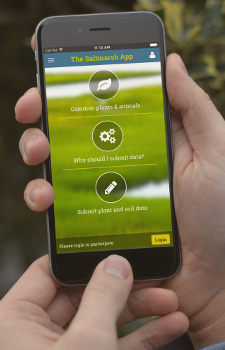Citizen scientists to investigate our saltmarshes
Marine scientists are appealing to citizen scientists to collect information about Britain’s saltmarshes with a new mobile phone app.
Using the free Saltmarsh App individuals can identify the specialised plants and wildlife found on saltmarshes and carry out an interactive plant and soil survey.
The information will form the basis of a survey to estimate the stored carbon in the saltmarsh soil and show how, by capturing carbon and reducing the concentration of the greenhouse gas carbon dioxide, the marsh is helping to limit climate change.
The Saltmarsh App was developed as a cooperation between Bangor and St Andrews Universities, with the Centre for Ecology & Hydrology. Every marsh survey uploaded will help the scientists learn more about UK saltmarsh soils and how they are helping fight climate change. A website – www.saltmarshapp.com – allows users to track theirs and other citizen scientists’ results, and to learn more about the science.
 The app will also encourage people to visit saltmarshes and gain more enjoyment from their visit, by providing a portable visual reference for the plants and animals found there. For the citizen scientists the app also guides the user through some simple plant community and soil identification steps, which will be fed back to the scientists.
The app will also encourage people to visit saltmarshes and gain more enjoyment from their visit, by providing a portable visual reference for the plants and animals found there. For the citizen scientists the app also guides the user through some simple plant community and soil identification steps, which will be fed back to the scientists.
Scientists know relatively little about the saltmarshes that fringe our coastline. Marshes are washed by the tides and are criss-crossed by creeks. They are rich in wildlife and help protect our coastlines against storms and floods.
Saltmarshes that occur on Scottish coasts are less well studied than those in other parts of the UK. In Scotland a saltmarsh is often identified by the term ‘fideach’ in Gaelic place names in the north west, and in south-west Scotland, extensive tidal saltmarsh is known as ‘merse’.
Professor David Paterson of the University of St Andrews, the leader of the CBESS research consortium behind the science used in the app said: “Saltmarshes are vital coastal habitats that play an increasingly important role in protecting land from flooding during storm surges and in adapting to sea level rise. It’s important that we build a better database of information about these beautiful systems, so that we can protect and manage them for the future.”
Dr Martin Skov of Bangor University’s School of Ocean Sciences, who is leading the Bangor group, said: “We hope people will use the app to go and investigate a saltmarsh the next time they visit the coastline. Marshes are just the most dramatic and atmospheric places to go to, and they are incredibly important for wildlife. By feeding back some simple information to us, we can build a better picture of what kinds of soils and carbon stores we have in our saltmarshes, and what type of plants and animals they support. This helps us build a better picture of how much carbon is naturally stored or ‘cycled’ along our coastline.”
The aim for the team is that the app will provide citizen scientists with a useful resource for getting involved in environmental biology or outdoor activities, and that the App will be useful to conservation groups, schools, high schools, Scout and Guide leaders, and groups completing the Duke of Edinburgh Award.
Notes to news editors
Image captions: (top) Saltmarsh on the Essex coast protecting against wind and waves; (bottom) Mock up of the Saltmarsh App
The Saltmarsh App is available to download for Apple and Android. The app will be maintained for up to five years, during which the scientists will be collating the information collected for their scientific use.
The Saltmarsh App was created as part of Coastal Biodiversity and Ecosystem Service Sustainability (CBESS): NE/J015644/1. The project was funded with support from the Biodiversity and Ecosystem Service Sustainability (BESS) programme. BESS is a six-year programme (2011-2017) funded by the UK Natural Environment Research Council (NERC) and the Biotechnology and Biological Sciences Research Council (BBSRC) as part of the UK’s Living with Environmental Change (LWEC) programme.
CBESS is a research consortium made up of universities, non-government organisations and statutory bodies: University of St Andrews, Bangor University, British Trust for Ornithology, Centre for Ecology & Hydrology, Durham University, University of Essex, Natural England, Natural Resources Wales, Queen’s University Belfast, Royal Society for the Protection of Birds, Scottish Association for Marine Science, Scottish Natural Heritage and University of Southampton.
Photographs are available. Professor Paterson is available for interview. Contact the Communications Office.
Issued by the University of St Andrews Communications Office, contactable on 01334 462530 or [email protected].
Category Research